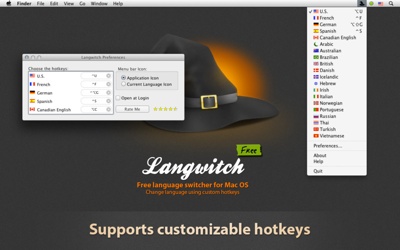CDFINDER 5.5 RELEASED
Langenhahn, Germany – January 5, 2009 — CDFinder, the leading disc
cataloging application for the Apple Macintosh, receives a massive
update today.
“The extended GeoFinder now uses an interactive map and Google Earth
integration to make searching for photos taken at a certain place,
using the GPS geotags in the photos, even easier. Also with improved
cataloging speed and the new support for movie files and XMP metadata
(Adobe Bridge), CDFinder again enhances the cataloging quality” said
Norbert M. Doerner, chief developer of the CDFinder team. But the new
release includes even more features, such as the unique support to
catalog disk images contained on any disk as well.
CDFinder for Macintosh is a Universal Binary and works with PowerPC
and Intel-Macs. A Windows version is available, compatible to Windows
2000, XP, 2003 Server and Vista.
The demo version of CDFinder is unlimited in time, but restricted to
25 catalogues. A single user license is 29 Euro / 39 USD. Multiple
licenses for business or network use are priced depending on the
number of clients and features required.
About CDFinder
Being one of the first cataloging tools for the Macintosh in the
market, CDFinder today is the most powerful cataloging software
available for Macs. Launched in 1995 it has evolved to a cross
platform application that also easily integrates in networks, and
offers superior work flow integration. CDFinder reads and catalogues
text files, photo-data, song files, and many other file formats from
various memory devices.
A typical Mac application, CDFinder is very easy to use. Useful
features like auto cataloging and a powerful and fast search engine,
which also includes a connection to Apples Spotlight search, make it
a powerful part of any work flow. CDFinder records more than just
standard data: It reads meta data of various picture formats, as well
as meta data of MP3 and AAC audio files, and adds title, year, and
genre to audio CDs. Even the content of zip and other archive types
are added to the catalogue.
The quality and ease of use has persuaded more than 22.000 private
users in 79 countries, as well as small and large businesses all over
the world. The list of CDFinder pro users also includes NASA, The New
York Times, Volkswagen, and IKEA.
For Windows users, a Windows version of CDFinder is available.
CDFinder 5.5 New Features Overview
Better cataloging:
– CDFinder now catalogs important metadata of movie files (avi, mov,
mp4, m4v, mpg, flv), such as the size and duration, as well as the
frame rate and codec
– Cataloging is much faster now, especially the creation of
thumbnails of very large photos no longer blocks the user interface.
You can now continue to work with CDFinder while cataloging several
large disks at the same time
– Stack Cataloging now works with multiple disk drives
simultaneously. Just feed any disk into any drive, and CDFinder will
rapidly catalog them all in parallel. Also, you can now set the
catalog label and comment for any cataloged disk directly from the
Stack Cataloging window
– CDFinder now catalogs XMP metadata out of RAW, TIFF, PDF, EPS, JPG,
and even sidecar files, increasing the compatibility to Adobe Bridge
and all other Adobe applications
– CDFinder can now also catalog the entire contents of disk image
files (.dmg, .img, and .cdr)! Yet again, CDFinder is the only
application available to offer this cool feature
– The extended eject menu in the Stack Cataloging window can now open
the tray of ejectable disk drives for you
Better GPS support:
– The new GeoFinder dramatically improves the Geo-Search feature: A
fully interactive map allows you to specify the starting point for
your search, and you can use the current Google Earth position, along
with preset locations and a new place search
– CDFinder can now export geotags into the KMZ format, including
previews of the actual photos and important metadata, such as the
location and camera parameters. That does of course work for any
photo formats
– All photos with GPS data now have the GeoIcon badged to their
thumbnail in the CDFinder windows
– CDFinder can upload your geotagged photos to www.locr.com! Simply
context click on any photo with a GeoTag, and use the context menu to
start the upload dialog
– When cataloging GPS data, CDFinder now also reads the azimuth,
tilt, and distance values written by Graphic Converter and some GPS
modules attached to Nikon cameras. This value is then used for
“Reveal in Google Earth”, as well as the KMZ export file
– The GPS location data of a photo can now copied to the clipboard,
using the context menu
– Added SmugMug, WikiMapia, Yahoo Maps, Geody, OpenStreetMap, and
Woophy to the GPS menu
Better finding:
– Find can now also search by path, e.g. finding all files contained
in a folder named “Star Trek” or such
– CDFinder can now handle a wide range of URLs, such as
cdfinder://find/gps/&city=Berlin&distance=5000m or
cdfinder://find/audio/&album=Crime%20Of%20The%20Century. You can use
that to interactively integrate CDFinder into your web sites and
more. Please read more about this amazing new feature in the new,
extended Users Guide
Other improvements:
– CDFinder now supports contextual menu modules just like the Finder
does. This vastly expands the workflow options from within CDFinder,
you can integrate Graphic Converter or Automator directly into
CDFinder
– Added a new view style to the CDFinder views: Blue. This looks like
the sidebar of Finder and iTunes
– CDFinder now fully supports Blue-Ray disks. Their type will be
detected when cataloging, and the whole cataloging process is fully
verified and certified for Blue-Ray now
– Extended the Export to include MP3, EXIF, and IPTC metadata of all
found items properly
– The IPTC metadata in any export now has no Return characters, but
these are replaced by either a comma or a blank
– Fixed a small problem with the Disk Stakka interface that could
cause disks with certain names to be overlooked
– CDFinder now accepts its own catalog files with drag & drop into
the catalog list. Any such files are now copied to the CDFinder
database folder and used
– When sorting, CDFinder now sub-sorts all items with the same label
by name for better lists
– Drawing in all CDFinder windows is much faster now, you should
notice that when resizing windows
– Improved the detection of bit depth of TIFF photos: CDFinder now
properly recognizes 24 and 48 bit images, and displays their color
depth correctly in the Inspector and elsewhere
– Fixed a small bug in the Find engine that could cause some
parameters to omit proper results (Find Kind is Photo AND name ends
with “.jpg” for example)
– Fixed a small problem that caused random photo files to be excluded
from cataloging, depending on their file size
– Fixed a small bug that could cause context clicks to be ignored, if
the view wasn’t activated already
– Fixed a small problem that caused the labels from the Finder to be
matched to the wrong CDFinder labels
– Fixed a small bug in AppleScript, where the found items would
report the wrong version string type (short and long always returned
the long version string)
– Fixed a small problem in the “Advanced Disk Catalog (ADC for
Windows)” importer, where some special characters in file or folder
names were imported incorrectly
The new CDFinder 5.5 can be obtained from the CDFinder Web Site
(http://www.cdfinder.de/).
The update is free to all existing users.



